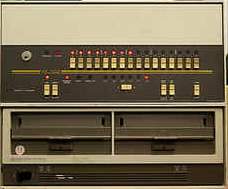HP 2100/1000 computer family
The first model in the Hewlett-Packard Company's (HP) minicomputer series, the microprogrammable HP 2100, was released in 1966, and from 1970 onwards, it continued to run as the HP 1000 — a predecessor to desktop computers, as a real-time computer. It was mainly used as a satellite for more powerful mainframes until 1990.
Below we describe the HP 2100 = HP 1000 model (pictured without power supply).
Use
n.a.
Outside the USA, various clones were very popular in Central Europe:
- In Poland known as PRS-4 (HP 2114B)
- In Czechoslovakia it was called ADT4000 (HP1000).
Structure
Central unit
Word processing machine: 16 bpW
- control system: main memory-centric data traffic, program counter (P) register only
- main storage: 4 – 15 KW, cycle time 1.6 μs;
- calculator: fixed-point arithmetic, 2 accumulator registers
Periphery
- backups:
- magnetic tapes (7970)
- hard drive (7900)
- external devices:
- punched tape reader (2748)
- impact line printer (2767A)
- 10 input/output interfaces
Operation
Instruction length 16 b (= 1 W); 68 / 70-element instruction set.
The average execution time of fixed-point basic operations is 1.6 μs = 0.625 Mips.
The main memory could be logically addressed in 1 KW pages: bits 14 – 0 of the P register
- If bit 15 = 0, the address of the next instruction
- If bit 15 = 1, the 15-bit address of the next instruction address (indirect addressing; if bit 15 = 1 here as well, indirect chaining continues).
The instructions were divided into 3 groups:
- 14 register↔store instructions; these operated on the contents of one accumulator and one main store word; their types were:
- arithmetic (addition, comparison, AND, OR, XOR)
- controller (jump, conditional jumps, subroutine call)
- load / store
- 39 register↔register instruction
- 17 input/output instructions.
Structure of register↔store instructions:
- if bit 15 = 0, then
- bits 14 – 11: operation code
- bit 10: page indicator
- bit 9 – 0: the factor's address within the page (0 -1023), namely
- If bit 10 = 0 on page 0
- If bit 10 = 1 on the current page (containing the instruction), then the page address is the same as the instruction (bits 14-10 of the P register)
- If bit 15 =1, then bits 14 – 0 are the main memory address of the factor, on any page.
In the register↔register instructions, bits 15–12 = 0000 (mandatory ); the instructions were executed by microprograms stored in the Write Control Store (actually an EPROM), from which groups of 1–4 elements were assembled according to user needs; but users could also write microprograms themselves, using the program supplied by HP.
In the input/output instructions, bits 15 – 12 = 1000 and bit 10 = 1.
Program set
- operating system: RTE-III, with limited file addressing capabilities
- compilers:
- assembler
- Fortran (editing, compiling, linking)
- utilities:
- B/K drive managers
Historical curiosities
Computers were marketed with unusually strong software support for their time.
The 2100's "ancestor" was the 2116A, which served as the basis for many later personal computers.
Thanks to its developments, HP was ranked 2nd in the world in PC sales by the beginning of the 21st century.
Created: 2016.06.29. 20:40
Last modified: 2020.07.24. 12:04

